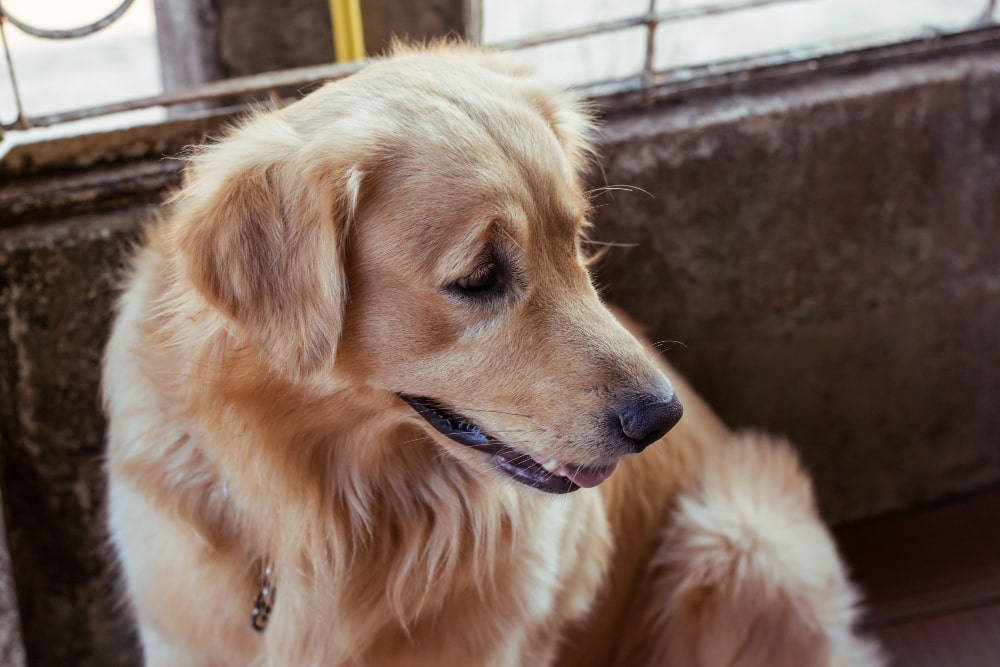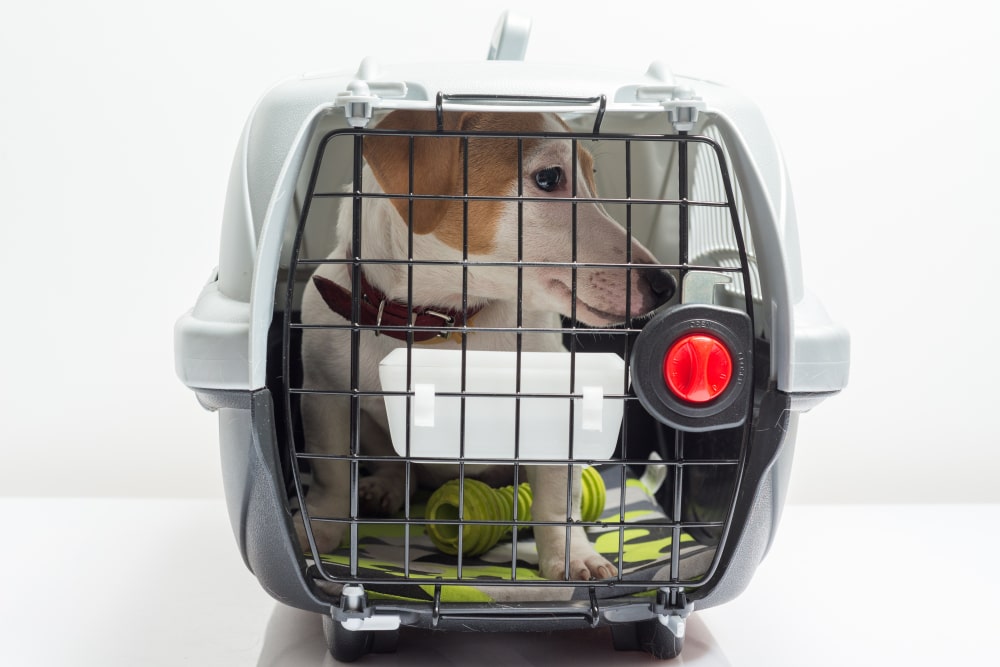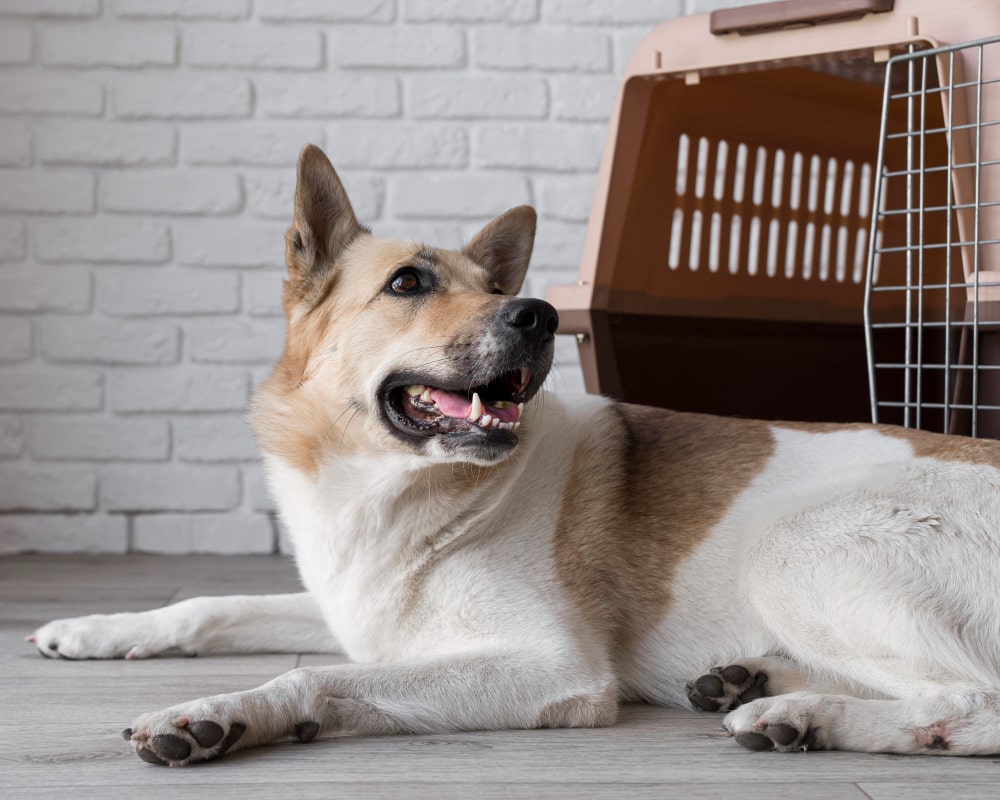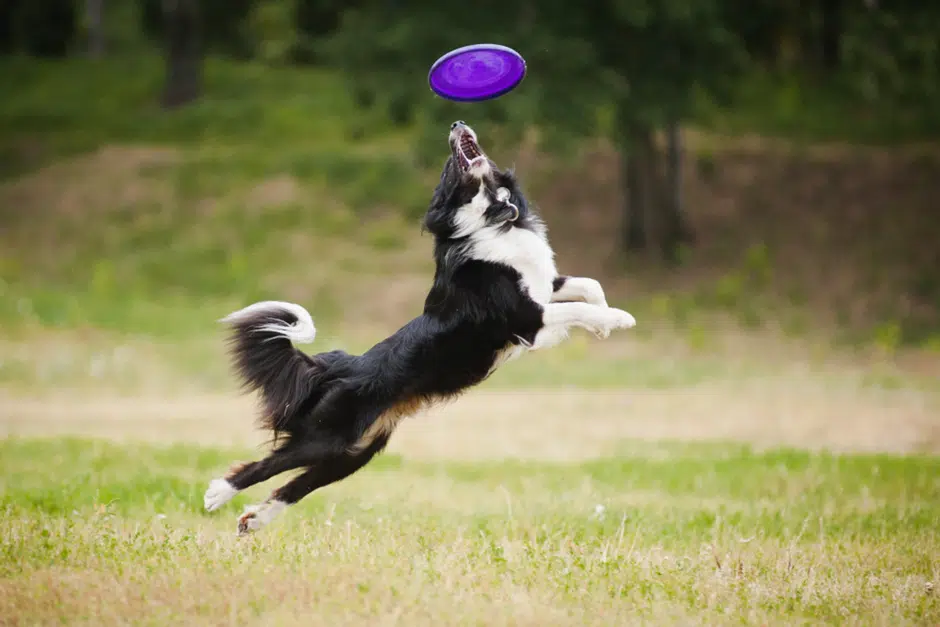Separation anxiety while in a dog crate is a prevalent issue among our canine companions. It’s a condition where dogs exhibit distress and behavior problems when separated from their primary human family. This emotional and physical challenge is not just taxing for the dogs but also for their owners, who often feel helpless seeing their pets in distress.
Understanding the natural instincts of dogs can provide insights into managing this anxiety. Dogs, by nature, are den animals. They often seek enclosed spaces, viewing them as a source of comfort and security. This is where crates come into play.
Contrary to the human misconception that they are mere “cages”, crates can serve as a dog’s den. Orvis News delves deeper into this, explaining the benefits of covering a dog’s crate to enhance this den-like feeling.
- Safety: Crates provide a safe environment, especially when owners are not around. They act as a protective barrier against potential hazards.
- Training Tool: Crates can be an innovative approach and a valuable training tool, helping dogs cope with being alone, and even potty training.
- Comfort Zone: A well-introduced crate becomes a dog’s personal space, offering comfort during times of stress and acting as their safe space.
Read more about Furlyfe’s training tips here.
For dog separation anxiety crate training cannot be overstated. As we delve deeper into your dog’s anxiety in this article, we aim to provide actionable advice for dog owners, emphasizing the role of crates in managing this anxiety.
Meet: Portuguese Pointer
The Science Behind Dog Separation Anxiety
Emotional and Behavior Signs of Separation Anxiety in Dogs
Separation anxiety in dogs is more than just a fleeting emotion; it’s a complex behavioral and emotional response. Dogs exhibiting this condition often show signs such as:
- Excessive barking
- Destructive behavior
- Attempts to escape
- Pacing or restlessness
- Dog exhibits extreme stress
These manifestations can be triggered by various events or changes in their environment, such as a shift in their daily routine, moving to a new home, or extreme stress from the absence of a family member.
Understanding the natural den instinct of dogs offers insights into their behavior. From an evolutionary perspective, dogs have always been den animals. These dens, or enclosed spaces, have historically provided them with a sense of safety and protection from predators.
There are common misunderstandings about this instinct. Many believe it’s about confinement, but it’s truly about providing a secure space.
Psychological benefits of Crates:
Safe Haven: They act as a refuge during stressful situations, offering a familiar environment.
Routine and Predictability: Crates can provide a predictable environment, which has a calming effect on dogs especially for rescue dogs.
Boundary Setting: Crates help in setting boundaries, giving dogs a sense of order and their own space.
Common concerns about crate usage:
Crate Misuse: Using crates as a form of punishment can have negative impacts on a dog’s behavior and perception of them.
Duration: It’s essential to ensure dogs aren’t confined for extended periods. Regular breaks and interactions are vital.
Integration: Balancing crate time with playtime, training, and other activities ensures a holistic approach to a dog’s well-being.
Understanding the science behind anxious behaviors, an anxious dog, crate training, and the role the crates play is pivotal in ensuring the emotional and physical well-being of our canine companions.
Meet: Portuguese Water Dog
Choosing the Right Crate for Managing Separation Anxiety
Selecting the right crate is more than just a purchasing decision; it’s about ensuring the well-being of your canine companion. The right crate not only ensures the safety of your dog but also provides them with a comfortable space, alleviating symptoms of separation anxiety and giving pet owners peace of mind.
When it comes to types of crates, each has its unique benefits:
Wire Crates: These crates offer excellent ventilation and visibility for the dog, making them feel less isolated. However, they might provide less privacy, which some dogs might prefer. Our Covering Crates article provides insights into how covering these crates can offer a more den-like feeling.
Plastic (Kennel or Airline) Crates: More enclosed, these crates can be a haven for dogs that seek privacy. The den-like feeling can be comforting, though they might compromise on visibility and ventilation.
Soft-sided Crates: Ideal for travel, these crates are lightweight and portable. However, their durability might be a concern for some, especially for dogs that are more active or anxious.
When choosing a crate, several factors come into play:
Size: It’s crucial to select a crate where your dog can stand, turn around, and lie down comfortably. A cramped crate can exacerbate feelings of anxiety.
Material: Consider the durability, ease of cleaning, and comfort. For instance, wire crates are easy to clean, while soft-sided ones might be more challenging to maintain.
Location: Place the crate in a quiet yet accessible part of your home. It should be a retreat for your dog, not an isolation chamber.
Lastly, transitioning your dog’s routine to their new crate should be a gradual process. Introduce them to it using positive reinforcement, place familiar items inside to make it inviting, and maintain consistency in your crate routines.
Choosing the right crate is a step towards a happier, more secure dog, especially for those battling separation anxiety.
Comprehensive Crate Training Steps for Managing Separation Anxiety
Crate training, when approached with understanding and patience, can be a transformative experience for both dogs and their owners. It’s not just about confinement; it’s about creating a sanctuary of safety and comfort. For dogs with separation anxiety, successful crate training can be a pivotal tool in their journey towards feeling secure.
Understanding the Importance of Crate Training
Building Trust: Successful crate training establishes a profound trust between the dog and the owner. It’s a mutual understanding where the the dog learns and recognizes the crate as a place of safety and not punishment.
Creating a Safe Space: For a dog with separation anxiety, the outside world can be overwhelming. The crate becomes their retreat, a place where the chaos of the world fades away.
Benefits for Owners: Beyond the obvious advantage of knowing their pet is safe, owners can also benefit from reduced household damages and a more harmonious living environment. Articles from The Wildest emphasize the balance between crate time and interactive play, ensuring dogs lead a well-rounded life.
Initial Steps to Introduce the Crate
Choosing the Right Location: Just as humans prefer a quiet bedroom over a roadside tent, dogs appreciate a crate located in a calm corner but still connected to the household’s pulse.
Making it Inviting: Think of the crate as a dog’s bedroom. Add their favorite toys, a comfortable bed, and even an item of your clothing. The familiar scent can be comforting.
Open Door Policy: Imagine being locked in a room without understanding why. It’s daunting. That’s why the initial days should allow the dog to explore the crate without any confinement, building their curiosity and comfort.
Positive Reinforcement Techniques
Treats and Praises: Celebrate the small victories. If your dog even sniffs the crate, reward them. Over time, this positive association will build.
Crate Games: Games like “Find the treat” where you hide a treat in the crate can make the experience fun. Resources like Orvis News offer creative game ideas to make the crate a fun space.
Consistent Commands: Just as “sit” means sit, commands related to the crate should be consistent. Whether it’s “crate” or “den”, stick to one.
Monitoring and Adjusting Crate Time
Start with Short Durations: Imagine studying for an exam. You wouldn’t study for 10 hours straight on the first day. Similarly, start with 10-15 minute intervals in the crate and gradually increase.
Observing Behavior: Dogs communicate through behavior. Pacing, whining, or excessive salivation can indicate distress. On the other hand, if they retreat to the crate during loud noises, it shows they find comfort there.
Avoiding Overuse: A crate is like a tool in a toolbox, useful but not the only solution. Ensure your dog also has ample playtime, training sessions, and cuddles outside the crate.
Addressing Potential Challenges With Your Dog’s Separation Anxiety
Whining or Barking: This could be a sign of distress or just a way to get your attention. It’s essential to differentiate between the two. If it’s the former, consider consulting a pet behaviorist.
Reluctance to Enter: Some dogs might be hesitant initially. Sharing meal times near the crate or placing their food bowl inside can create a positive association.
Safety Precautions: Always prioritize safety. For instance, ensure there are no sharp edges inside, and the crate has ample ventilation.
In conclusion, crate training, when done with empathy and understanding, can be a game-changer. It’s not just about managing your dog’s separation anxiety but also about providing a space where your dog feels truly at home.
Meet: Pyrenean Mastiff
FAQs about Dogs with Separation Anxiety and Crate Training
Navigating the world of dogs with separation anxiety and the steps to crate train can be overwhelming. To help, we’ve compiled a list of frequently asked questions to provide clarity and guidance.
1. Is it cruel to crate a dog for long hours?
Crating a dog for extended periods can be detrimental to their physical and emotional well-being. It’s essential to ensure that dogs have ample time outside the crate for play, exercise, and interaction. A balanced approach is key.
2. How long is too long for a dog to be in a crate?
While there’s no one-size-fits-all answer, puppies shouldn’t be crated for more than 3-4 hours at a time. Adult dogs, especially those accustomed to crates, can handle longer durations, but they still need regular breaks. The Wildest offers insights into ensuring a dog’s crate time is balanced with other activities.
3. Can crate training worsen separation anxiety?
If misused, crates can exacerbate separation anxiety. However, when used correctly, they can be a safe haven for anxious dogs. It’s crucial to introduce the crate positively and avoid using it as a form of punishment.
4. How to ensure the dog sees the crate as a positive space?
Positive reinforcement is vital. Reward your dog for entering the crate, use consistent commands, and make the crate comfortable with bedding and toys. Avoid using the crate as a punishment zone.
5. What if my dog is reluctant to enter the crate?
Patience and consistency are essential. Use treats, toys, and positive reinforcement to make the crate appealing. Over time, with positive associations, most dogs will come to accept and even enjoy their crate.
6. Are there alternatives to crates for managing separation anxiety?
Yes, there are alternatives like playpens, dog-safe rooms, or even doggy daycare. The best solution depends on the individual dog and the owner’s circumstances. For more information on how to relieve dog pet anxiety read Diggs Pet.
Understanding your dog’s needs and concerns is pivotal. By addressing these common questions, we hope to make the journey of managing your dog’s stress and separation anxiety a bit smoother for both dogs and their owners.
Conclusion: Embracing the Crate as a Safe Haven
Navigating the challenges of a dog with separation anxiety can be a daunting journey for both the pet and the owner. However, with the right tools and understanding, it’s a journey that can lead to a harmonious and trusting relationship. The crate, often misunderstood, emerges not as a tool of confinement but as a sanctuary of comfort and security.
Through comprehensive crate training programs, positive reinforcement, and consistent care, it becomes more than just a structure; it transforms into a personal space where your dog feels safe, loved, and at ease. As we’ve explored in this article, the key lies not just in the physical crate but in the approach we take towards it. In the end, it’s about building trust, understanding needs, and ensuring that our furry friends always have a place they can call home.











Get involved!
Comments